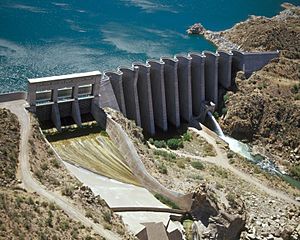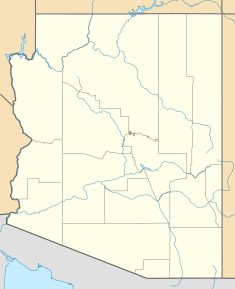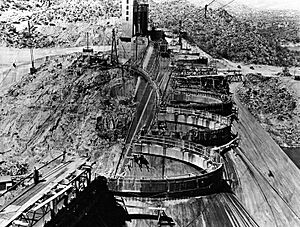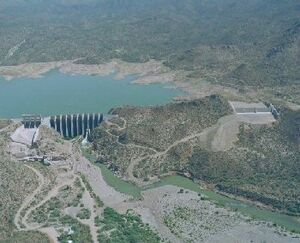Bartlett Dam facts for kids
Quick facts for kids Bartlett Dam |
|
|---|---|

Bartlett Dam
|
|
|
Location of Bartlett Dam in Arizona
|
|
| Location | Tonto National Forest, Maricopa County, near Phoenix, Arizona |
| Coordinates | 33°49′5″N 111°37′54″W / 33.81806°N 111.63167°W |
| Status | In use |
| Construction began | 1936 |
| Opening date | 1939 |
| Owner(s) | Salt River Project |
| Operator(s) | U.S. Bureau of Reclamation |
| Dam and spillways | |
| Type of dam | Concrete, multiple-arch buttress |
| Impounds | Verde River |
| Height | 308.5 ft (94.0 m) |
| Length | 823 ft (251 m) |
| Width (crest) | 4.5 ft (1.4 m) |
| Width (base) | 7.5 ft (2.3 m) |
| Dam volume | 223,773 cu yd (171,087 m3) |
| Spillway type | Service, gate-controlled |
| Spillway capacity | 287,500 cu ft/s (8,140 m3/s) |
| Reservoir | |
| Creates | Bartlett Lake |
| Total capacity | 178,186 acre-feet (219,789,000 m3) |
| Catchment area | 6,160 sq mi (16,000 km2) |
| Surface area | 2,700 acres (11 km2) |
The Bartlett Dam is a large concrete dam on the Verde River in Arizona. It is about 50 kilometers (31 miles) northeast of Phoenix, Arizona. This dam creates Bartlett Lake, which holds water mainly for irrigation, meaning it helps supply water to farms.
The Bartlett Dam was the first dam built on the Verde River. It was also the first of its kind, called a multiple-arch buttress dam, built by the U.S. Bureau of Reclamation. This is a government agency that builds dams and manages water projects. The dam was built between 1936 and 1939. It was named after Bill Bartlett, a government surveyor. In 2017, it was added to the National Register of Historic Places, which lists important historical sites.
Building the Dam
During the Great Depression, many people struggled to find jobs. Farmers also had a tough time because crop prices dropped. They really needed a dam on the Verde River to help with water for their crops.
In 1935, the Salt River Project (SRP) got permission to build the Bartlett Dam. The U.S. Bureau of Reclamation then built the dam. It took 1,000 days, from 1936 to 1939. When it was finished, the Bartlett Dam was the tallest multiple-arch buttress dam in the world!
The Salt River Project paid for 80% of the dam. The Bureau of Indian Affairs, a government agency working with Native American tribes, paid the other 20%. Building the dam created many needed jobs. It also helped control floods on the river. Even though floods stopped construction for a short time in 1937, the dam later helped prevent big floods.
Because of safety concerns, the dam was made even stronger in the mid-1990s. Starting in 1994, the dam was raised by 21.5 feet (6.6 m). Its main spillway, which is like a channel for water to flow out, was also changed. A new spillway was built too, about 1,500 feet (460 m) south of the dam. This new spillway has a special part called a fuse plug. It is designed to break apart in stages during very big floods to release water safely. All these changes were finished in December 1996.
How the Dam Works
The Bartlett Dam is made of 10 arches and 9 large supports called buttresses. It also has two "gravity wing dams" on its sides. Before it was made taller, the dam was 287 ft (87 m) tall. It used 182,000 cu yd (139,000 m3) of concrete.
After the changes in the 1990s, the dam is now 308.5 ft (94.0 m) tall. It used a total of 223,773 cu yd (171,087 m3) of concrete. The dam is 823 ft (251 m) long. The arches of the dam are 7.5 ft (2.3 m) wide at the bottom. They get narrower at the top, measuring 4.5 ft (1.4 m) wide.
The lake created by the dam, Bartlett Lake, can hold 178,186 acre-feet (219,789,000 m3) of water. This is when the water is at its normal level of 1,798 ft (548 m). The lake collects water from an area of 6,160 sq mi (16,000 km2). Its surface area is 2,700 acres (11 km2).
The dam has special "outlet works" that can release 2,400 cu ft/s (68 m3/s) of water. When the lake is at its highest water level of 1,821 ft (555 m), the main spillway can release 287,500 cu ft/s (8,140 m3/s) of water. The extra spillway can release up to 261,700 cu ft/s (7,410 m3/s) of water.




